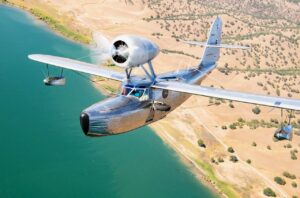Project Description

MPH
SEATS
Fleetwings Seabird
Role: Single Pilot Amphibious Aircraft
National Origin: United States
Manufacturer: Fleetwings
First Flight: 1936
Primary User: US Commercial/Utility
Number Built: 5
The silver “Seabird” by Fleetwings was pretty much an unusual airplanes but unique mainly because it was built of spot welded stainless steel construction. It was not the first airplane to be built up in this manner, but it was the first airplane of “stainless” to be awarded an ATC approval, and the first airplane of this type to be built in any number.
The initiative for this departure from normally used materials came from the steel industry. Much development money was gambled in hopes that more steel could be used in airplane structures, thereby developing a new market for steel sheet. Intrigued with the possibility of building a strong, efficient airplane of stainless steel, Fleetwings experimented for several years to perfect fabrication methods, and the design of structural members best suited for the unusual properties of stainless steel sheet. No doubt, Fleetwings, Inc. picked the “amphibian” as their first airplane to produce because a water-going airplane would certainly be the test for this type of construction, and the many innovations it promised. The former “Keystone” plant in Bristol, Pa. and right on the shore of the Delaware River, was acquired for the production of these airplanes which was planned in the hundreds. That they picked a somewhat flimsy-looking, wire-braced monoplane seems a little odd, but all in all, it proved to be a tough airplane and a rather serviceable con-figuration. It is remarkable to note that of the six airplanes that were finally built, there are two that are flying yet.
The burnished Fleetwings “Seabird” model F-5 was a wire-braced, high-winged cabin monoplane of the flying-boat type with seating arranged for 4 or 5. A novel retracting landing gear allowed it to operate as an “amphibian” off land or water. With design goals set to overcome some of the compromises inherent in an airplane that operates both from land and water, the “Seabird” got around most of these handicaps nicely, and was rolled out as quite an airplane. The “Seabird” amphibian practically had the market for this type of airplane all to itself, but oddly enough, “amphibians” were not selling all that well, so Fleetwings had very few names on the order-books. But, because it was an oddity and a very unusual airplane at that, its press coverage and its exposure to the trade was far beyond what it had actually earned. For Fleetwings it was nice to have all that publicity, but it did very little good.
As powered with the Jacobs L-5 engine of 285 h.p. the “Seabird” turned in whopping good performance despite the handicaps present in the design of the type; it was capable, fast, and economical. Its water behavior was excellent, but the high-mounted engine made land operations a little touchy; it was top-heavy. The airplane was docile in the air having pleasant characteristics, it was comfortably stable yet quite maneuverable. The “Seabird” did require a little special care in its handling, but it was practically ageless, and maintenance was minimal during normal operation. The type certificate for the “Seabird” model F-5 was issued retroactive to 10-30-37 and only 5 examples of this model were manufactured by Fleetwings, Inc. on the banks of the Delaware River in Bristol, Pa.
The surviving Seabird, NC16793, was owned and flown by Channing Clark of Los Angeles from 1963 until his passing in 2004. Ownership passed through Greg Herrick and Walt Bowe before joining the museum collection in 2023. It went on display at the museum in November of 2023.
General characteristics
- Crew: 1
- Capacity: 3 pax
- Length: 32 ft
- Wingspan: 40 ft 6 in
- Height: 12 ft 6 in
- Wing area: 235 sq ft
- Powerplant: 1 × Jacobs R-755 air-cooled radial piston engine, 300 hp
- Propellers: 2-bladed fixed-pitch propeller
- Empty weight: 2,500 lb
- Gross weight: 3,800 lb
Performance
- Maximum speed: 150 mph
- Cruise speed: 130 mph
- Range: 520 mi
- Service ceiling: 14,500 ft